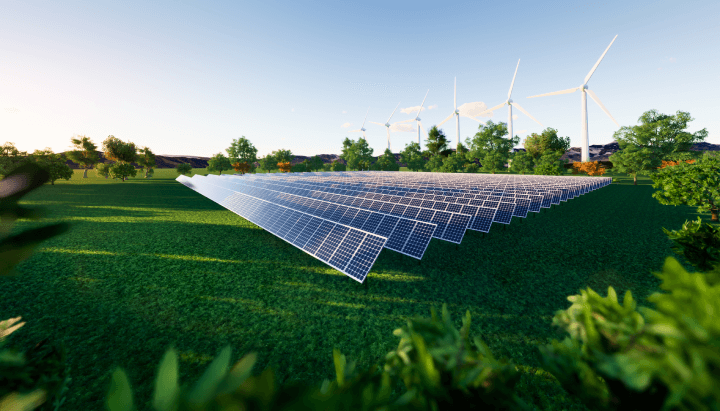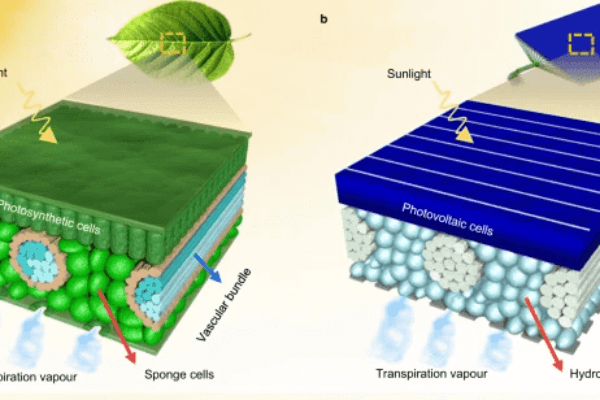Nature's Blueprint: How Leaves Inspire Cooler Solar Panels
Insights | 07-09-2023 | By Robin Mitchell
As the world continues to see increased demand for renewable energies, the need for improving efficiency has never been more important. Taking inspiration from nature, researchers have recently developed a new cooling technique that has been shown to improve solar panel efficiency substantially without any additional power needed. What challenges do solar panels face with regard to heat, what did the researchers develop, and how could such a technology help to reduce CO2 emissions?

What challenges do solar panels face with regard to heat?
Of all renewable energy sources, solar and wind are by far the two most practical. While hydroelectric systems can produce vast quantities of energy, they can only be built where large volumes of water traverse a landscape (such as mountains and rivers), and geothermal systems can only be built in areas where ground heat is sufficient and close to the surface. As most places have some degree of wind and sunlight, solar panels and wind turbines are often applicable in most places around the world (either one or both).
Wind turbine technology has essentially gone as far as it can go due to the basic nature of its design and the physical limitations of wind energy conversion (Betz’s Law states that a wind turbine’s max efficiency can only be 59.3%). These turbines can be made larger to produce more power, but with regard to their efficiency, it is unlikely that major gains will be seen in the coming years.
Solar Panel Efficiency and the Impact of Heat
Solar panels, however, have a large room for improvement with regards to efficiency, with typical panels having an efficiency between 15% and 20% and the maximum theoretical limit being around 33% for single-junction cells. For example, researchers are actively exploring additional layers to add to solar cells that allow them to convert infrared light to electricity (and not just the narrow visible band).
Of all the factors that reduce solar panel efficiency during operation, high temperatures are often the most significant. An optimum temperature for panels to operate at is around 25˚C, but for degrees above, the output power can decrease between 0.3% to 0.5%. Thus, a panel that reaches 50˚C can see an output power fall by 10%. Furthermore, with increased temperatures, solar panels experience a faster rate of ageing, leading to a lower lifespan (thus increasing the system cost over its lifetime).
However, due to their nature of being placed in direct sunlight, solar panels are often significantly hotter than the surrounding air, meaning that air temperatures of 30˚C does not correspond to a panel temperature of 30˚C. Just like how a car dashboard can exceed 60˚C even in the UK, solar panels can quickly become hot even when used in cooler climates.
In a study published in ScienceDirect, the detrimental effects of heat on solar panels were further explored. The study highlighted that as global temperatures continue to rise, the efficiency of solar panels could be further compromised, making innovations in cooling technologies even more crucial.
As a result, it is not uncommon for solar panels to perform better in cooler climates, such as the UK, compared to hotter climates that have more sunlight (such as deserts). In fact, solar panels placed in cooler climates with more cloud cover can actually produce more energy than those in arid climates if those panels receive both direct sunlight and light reflected off clouds.
To summarise, heat is a major concern for solar panels as it can drastically reduce output power, increase ageing, and reduce their economic incentive.
Researchers create artificial leaves to cool solar panels
Cooling a solar panel can help improve its efficiency, but if energy is spent in the cooling process (such as running pumps and refrigerants), it is most likely that the spent energy will be greater than what is gained from cooling, thus rendering such a system impractical. It is possible for solar panels fitted to residential systems to use active water cooling for the purpose of hot water, but such a mechanism would only ever work on small scales and would be faced with a mountain of issues.
However, a team of researchers from Imperial College UK have taken inspiration from nature and developed a new cooling technique for solar panels that requires no energy. The new design is inspired by leaves that use capillary action to pull water through its structure, even against gravity.
To create the leaf-inspired design, the researchers took bamboo fibres and hydrogel to create a sheet material that consists of microchannels which water can be transported through. Suspended in a Potassium Polyacrylate super absorbent polymer, water is then evenly distributed over the entire area, acting as a swamp cooler. The 1mm sheet can be added to the back of a typical PV panel, and both fresh and saltwater can be used with passive cooling technology.
Drawing parallels with a study from Imperial College, hybrid solar energy systems that combine traditional photovoltaic cells with other technologies can also significantly boost efficiency. Such hybrid systems, when combined with passive cooling technologies like the artificial leaf, could revolutionise the solar energy sector.
According to the researchers, the new sheet was able to provide enough passive cooling to reduce the temperature of a panel by as much as 26˚C. Data comparing the modified panel to an identical unmodified panel showed an electrical efficiency increase from 13.2% to 15% and an increase in panel voltage from 0.58V to 0.63V. Finally, the unmodified panel reached temperatures of 68.8˚C, while the passively cooled panel only reached 43.2˚C.

How could such technologies help to reduce CO2 emissions?
If the new technology can be scaled cheaply and added to existing panels, the use of passive cooling would help to increase the energy output of solar farms due to the increased efficiency. By generating more renewable energy, there would be a reduction in demand for fossil fuels, thereby reducing global CO2 emissions.
However, the development of such panels also helps to reduce the CO2 footprint of solar panels. As we previously reported, it is believed that solar panels produce 3 times more CO2 than previously thought due to manufacturing and recycling processes, and this larger CO2 impact makes solar panel technologies harder to justify. But, if panel efficiency can be increased, then not only are the panels offering greater energy returns, but their life expectancy is also increased due to the reduction in operating temperature. Thus, such panels can remain in service for longer periods of time, thus reducing the need for replacements.
Overall, what the researchers have demonstrated with their new leaf-based technology has the possibility to introduce very real gains in solar energy production.

